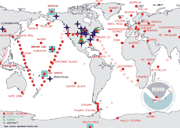
skip to content program navigation
| Learn more about these CLIMATE RESEARCH areas... |
The Global Carbon Cycle
Why It's Important
Atmospheric carbon dioxide comes from a variety of sources, some of them natural, but increasingly from human activities. Carbon dioxide and other gases (together, known as "greenhouse" gases) in the atmosphere absorb radiation emitted from the Earth, trapping heat in the atmosphere and contributing to the warming of Earth's atmosphere. Although a greenhouse also works by trapping energy from the sun, the physical processes are different (See this university site for a more detailed explanation). NOAA researchers are very interested in the sources and storage systems of many "greenhouse gases."
In the geological history of the Earth, carbon has been cycling among large reservoirs in the land (including plants and fossil fuels), oceans, and the atmosphere. This natural cycling of CO2 usually takes millions of years to move large amounts from one system to another. Now we are looking at these changes occurring in centuries or even decades.
Since the Industrial Revolution in the 19th century, carbon dioxide in the atmosphere has risen by 30 percent. This follows the increase in burning of fossil fuels that began with the rise of industry and transportation.
NOAA's Goals
One of NOAA's major mission goals is to "understand climate variability and change to enhance society's ability to plan and respond." This is why NOAA scientists are examining the entire global carbon cycle - including the Earth's atmosphere, fossil fuels, the oceans, and terrestrial ecosystems -- to better understand how the carbon cycle works and to help us predict how it will act and react in the future.
NOAA Research
NOAA Research has been studying various aspects of the carbon cycle for a number of years. Because the ocean plays an important role in regulating the amount of CO2 in the atmosphere and regulating climate variability, NOAA's ocean-oriented labs are involved in this issue. At NOAA's Pacific Marine Environmental Laboratory Carbon Dioxide Program, located in Seattle, Washington, scientists conduct ocean carbon cycle research from ships and moorings in all of the major ocean basins in collaboration with NOAA's Atlantic Oceanographic and Meteorological Laboratory's CO2 Program.
A recent study looked at distribution and impacts of carbon dioxide in the world's oceans. This study is one example of the critical role the oceans play in removing anthropogenic (derived from human activities) carbon dioxide from the atmosphere.
NOAA's Climate Program Office supports research to improve our ability to predict the fate of human-made CO2 and how much will end up in the atmosphere in the future using atmospheric and oceanic global observations, process-oriented field studies and modeling. Its priorities are to study the sources of CO2 and its sinks, that is, reservoirs for CO2 outside the atmosphere, such as large forests.
ESRL's global monitoring division in Boulder, Colorado, maintains a global air sampling program that is useful in telling researchers where carbon dioxide is coming from, and where it is going. These careful, continuous and consistent measurements all over the globe are key to monitoring levels of atmospheric carbon dioxide globally, serving as benchmark measurements for climate process studies and models.
The keystone site of NOAA's monitoring network is on the flank of the Mauna Loa volcano in Hawaii, where continuous CO2 measurements have been taken since 1957, resulting in one of the best recognized graphs in science today. The Mauna Loa observations were begun by a pioneer in carbon cycle science, the late Dr. Charles "Dave" Keeling.
These is a story behind every one of the sampling sites managed by NOAA. One story tells about the retired school teacher in Mongolia who collects air samples for NOAA's network.
Recognizing the integrated nature of the carbon cycle,
six federal agencies (DOE, NASA, NSF, NOAA, USDA, and USGS) are coordinating
their individual carbon cycle research programs into a partnership, the
Carbon Science Cycle Program,
to address common research goals outlined in A
U.S. Carbon Cycle Science Plan ![]() .
.
NOAA Researchers joined an international team of scientists to measure the carbon dixoide stored in the world's oceans. (larger image)
The CCGG Cooperative Air Sampling Network includes surface, observatory, aircraft and tower atmospheric measurements (larger image)
Possibly the best known graph in carbon cycle science is the long, continuous record of carbon dixoide measurements at Mauna Loa, Hawaii. (larger image) |
NOAA Research Programs that study the Global Carbon Cycle
![]() Climate Program Office (CPO)
Climate Program Office (CPO)
![]() Earth
System Research Laboratory (ESRL)
Earth
System Research Laboratory (ESRL)
![]() Pacific
Marine Environmental Laboratory (PMEL)
Pacific
Marine Environmental Laboratory (PMEL)
![]() Atlantic
Oceanographic and Meteorological Laboratory (AOML)
Atlantic
Oceanographic and Meteorological Laboratory (AOML)



